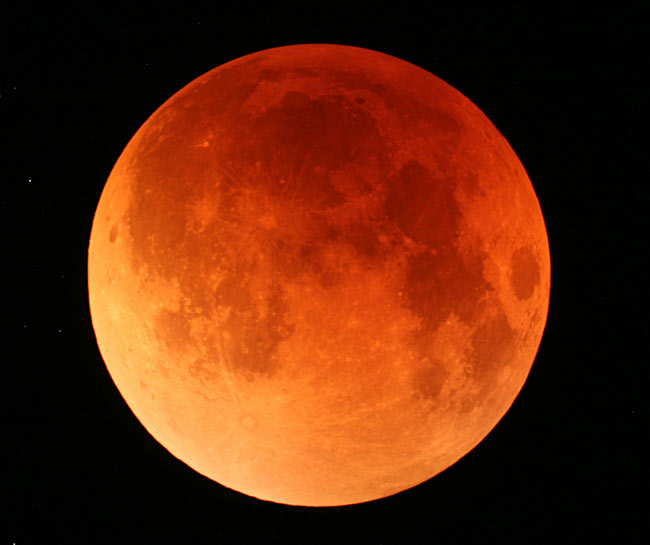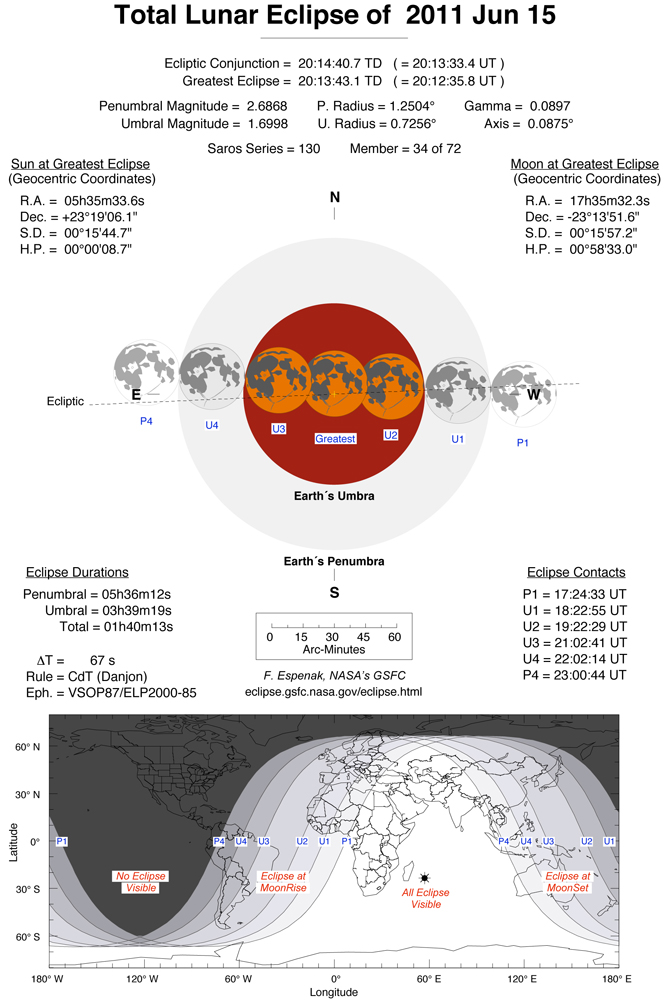Spellbinding-Long Total Lunar Eclipse Occurs Next Week

This month's full moon will pass almost directly through the center of Earth's shadow on Wednesday (June 15) in what will be an unusually long total eclipse of the moon.
The lunar eclipse will occur just two weeks after a June 1 partial solar eclipse, when the moon blocked part of the sun as viewed from Arctic regions. The eclipse won't be visible from North America due to its timing, which places the event in the daylight hours when the moon is behind the local horizon.
But the Eastern Hemisphere of Earth will be facing the moon during the eclipse. This hemisphere, centered on a spot in the Indian Ocean to the east of the island nation of Madagascar, will have a ringside seat for this event. [Video: Inside the June 15 Total Lunar Eclipse]
Since the Earth rotates during the several hours of the eclipse, more than a hemisphere sees stages of it.
Where the best views may be
For all of the places mentioned below, next week's lunar eclipse will be taking place during the morning early hours of Thursday (June 16) as they are west of the International Date Line.
For moon-gazers in Russia's Sakhalin Island, moonset virtually coincides with the moon's entry into the umbra (1823 GMT). The beginning of penumbral eclipse starts about an hour earlier, before the moon sets, but this is only a theoretical matter since the outer part of the penumbra (the Earth's shadow) is imperceptible even high in the sky. [Blood Moon: Photos of 2010 Total Lunar Eclipse]
Breaking space news, the latest updates on rocket launches, skywatching events and more!
Skywatchers in Central Siberia, eastern Mongolia, northeast China, and most of Japan, Korea, New Guinea, eastern Australia and New Zealand will see the moon entering the darker shadow, called the umbra. But only as it's going down in the west-southwest at the end of the night does the moon becomes totally eclipsed (at 1922 UT).
On the other side of the globe, a slice of eastern South America, Western Europe and the west coast of Africa will see the moon emerge from above their east-southeast horizon on the evening of Wednesday (June 15), already in total eclipse.
As the moon climbs higher in the sky, skywatchers may be able to watch it slowly emerge from the Earth's shadow beginning at 2102 GMT.
You may recall that in early January, European cities such as Oslo, London, Paris and Madrid were all treated to a solar eclipse at sunrise. Now, just over half a year later they'll all see a lunar eclipse at moonrise.
What to look for
In the sky, the moon will crossing through the non-zodiacal constellation of Ophiuchus and will be positioned roughly halfway between the bright red star Antares in Scorpius and Nunki, the brightest star in the handle of the Teapot asterism of Sagittarius. The star clouds of the summer Milky Way in this particular region of the sky are bright and spectacular; sweeping with binoculars or a rich-field telescope reveals a mass of innumerable stars.
Of course, before the eclipse begins the moon will completely obscure these faint stars of the Milky Way, but as it gradually becomes more and more immersed in the Earth's shadow, the sky will correspondingly darken.
During totality, the moon will appear 10,000 to 100,000 times dimmer and will seem almost three-dimensional; like an eerily illuminated ball from a non-light polluted location, the beautiful summer Milky Way appears nearby as a striking backdrop.
And as a bonus, according to Phillip S. Harrington in his book "Eclipse!" (John Wiley & Sons Inc., 1997) during totality, the moon will occult the 9th magnitude globular cluster NGC 6401. Notes Harrington: "The best place to see the event will be in central Asia. There, as well as in eastern Europe and northeastern Africa, observers will see the moon occult the cluster in a comparatively dark sky."
A long lunar eclipse
At mid-eclipse (2013 GMT), the moon will be passing just to the north of the center of the Earth's shadow.
As such, the duration of totality is an unusually long 100 minutes, which is just seven minutes shy of the absolute maximum for a total lunar eclipse. In fact, over the last 100 years, only three other eclipses have rivaled the duration of totality of this eclipse: The total lunar eclipse of July 16, 1935, lasted 101 minutes; the eclipse of July 6, 1982, lasted 107 minutes; the eclipse of July 16, 2000, lasted 107 minutes.
The next total lunar eclipse of exceptional length will come on July 27, 2018, and will last 106 minutes.
On Dec. 10, 2011, another total lunar eclipse will be visible before the moon sets over the western United States and Canada. After that, the next total lunar eclipse that will be widely visible across all of North America will be on April 15, 2014.
If you plan to observe or photograph the total lunar eclipse of June 15 and would like to share your comments and images with SPACE.com for a possble story or image gallery, contact Managing Editor Tariq Malik at: tmalik@space.com.
Joe Rao serves as an instructor and guest lecturer at New York's Hayden Planetarium. He writes about astronomy for The New York Times and other publications, and he is also an on-camera meteorologist for News 12 Westchester, N.Y.

Joe Rao is Space.com's skywatching columnist, as well as a veteran meteorologist and eclipse chaser who also serves as an instructor and guest lecturer at New York's Hayden Planetarium. He writes about astronomy for Natural History magazine, Sky & Telescope and other publications. Joe is an 8-time Emmy-nominated meteorologist who served the Putnam Valley region of New York for over 21 years. You can find him on Twitter and YouTube tracking lunar and solar eclipses, meteor showers and more. To find out Joe's latest project, visit him on Twitter.

